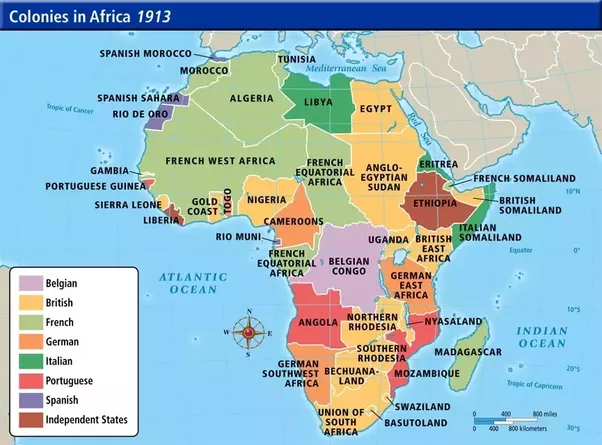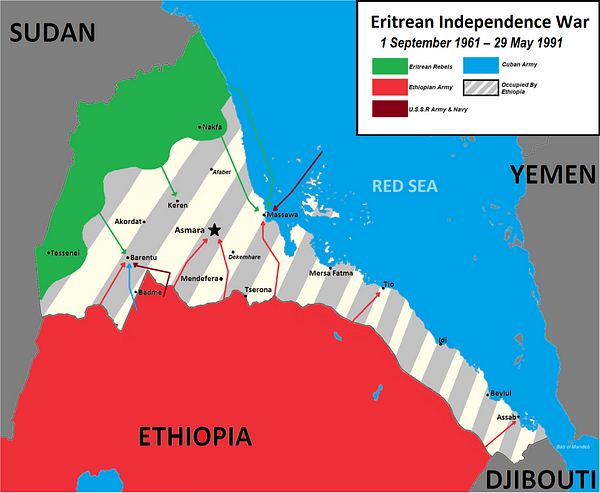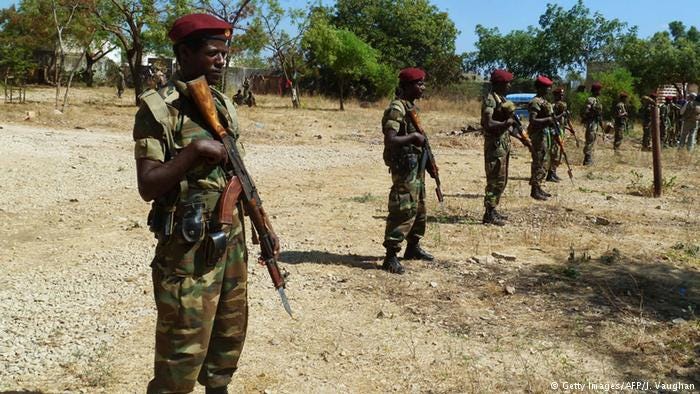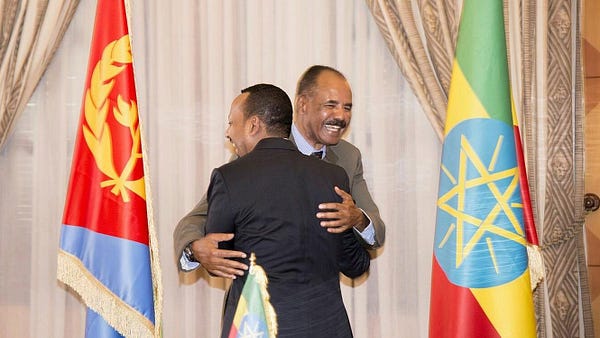As pre-colonial empires and kingdoms ruled the Horn of Africa, borders shifted and were constantly debated. However, colonization at the end of the 19th century was the true turning point in determining the future of modern-day Ethiopia and Eritrea, as well as the future of the entire continent.
In 1890, after successfully defeating an autonomous kingdom of the Ethiopian Empire along the coast, Italy established the colony of Italian Eritrea during the height of European imperialism in Africa. Ethiopia itself (also known as Abyssinia at the time) was never formally colonized despite interest from several European powers looking to increase their influence in the region, including Italy who already maintained two colonies in the Horn of Africa. In 1896, Ethiopia successfully defeated Italy in the Battle of Adwa securing its autonomy for the time being. They both signed a treaty specifically delineating the border between Ethiopia and Italian Eritrea, forcing Italy to recognize Ethiopia’s sovereignty. Ethiopia and Italy would remain in their separate territories for the next forty years.

Despite Ethiopia and Italy’s membership to the collective security organization, the League of Nations, Italy’s leader Benito Mussolini invaded Ethiopia between 1935–36 with aspirations of greater influence in Africa. Italy occupied Ethiopia for five years and joined it with Eritrea and Italian Somaliland to create the greater colony of Italian East Africa. Despite occupation, resistance in Ethiopia continued. When the British started fighting Italy in WWII, they also took the fight to Africa where they helped liberate occupied Ethiopia and colonized Eritrea in spring of 1941.
Ethiopia regained independence and emperor Haile Selassie returned from exile in May 1941. Eritrea was placed under British military administration until decisions could be made about its future. After WWII ended, Ethiopia sought to annex Eritrea and started to move forward with this goal. Many in the international community had different ideas about what to do with Eritrea — give it to Ethiopia, divide it and distribute it to different countries, return Eritrea to Italy, make it an independent state, or even make it a part of the Soviet Union. Meanwhile on the ground in Eritrea, there was a large indepence movement that wanted the country to become its own sovereign state. In 1952, the UN General Assembly decided to federate Eritrea with Ethiopia in a decision that would keep the two countries at odds for decades.

Eritrea was able to maintain some autonomy with the decision, but about a decade later, Ethiopian emperor Haile Selassie dissolved the federation and annexed Eritrea. This prompted a thirty-year armed conflict between Ethiopia and Eritrea that lasted from 1961–1991. After Haile Selassie was ousted in a coup in 1974, the Derg, a Marxist military dictatorship backed by the Soviet Union, took over Ethiopia with its new leader Mengistu Haile Mariam. This started the Ethiopian Civil War. Meanwhile, the war with Eritrea continued with the new regime. The Eritrean Liberation Front (ELF) led independence struggles in the region in the 1960s; by the late 1970s, the ELF had fractured and the Eritrean People’s Liberation Front (EPLF) came out as the dominant group with Isaias Afwerki as its leader. By the end of the 1980s, the Soviet Union withdrew its support of Ethiopia as the Ethiopian People’s Revolutionary Democratic Front (EPRDF) gained momentum and Mengistu Haile Mariam resigned and went into exile. At this same time, after years of insurgency, Eritrea won independence in 1991, leaving Ethiopia landlocked and both countries on the path to further change.
Following the collapse of the Mengistu government, a conference was held in July 1991 to establish a transitional government in Ethiopia. Eritrea observed the conference and held talks in hopes of finding a peaceful way to independence. As a result, an agreement was made for the right of Eritreans to hold an independence referendum. In April of 1993, in an almost unanimous vote, the Eritrean people voted for an independent and sovereign Eritrea. The following month in May 1993, Eritrea was admitted into the UN — its independence officially recognized. Eritrea reorganized its government and chose EPLF leader Isaias Afwerki as president. Despite what seemed to be a hopeful and peaceful future, Ethiopia and Eritrea would continue to be at odds.
In 1998, only 7 years after thirty-year Eritrean War of Independence, Eritrea and Ethiopia disputed over the border town of Badme which sparked the Eritrean-Ethiopian War. Both countries, already facing high poverty rates and other internal problems, suffered mass casualties and spent hundreds of millions of dollars on the war. Ethiopia claimed that Eritrea was a historical part of the country, but also used colonial treaties to justify their claims to border towns. The fighting escalated despite international intervention, and resulted in further destabilization in the region as the fight spread to neighboring Somalia and Sudan. The war also caused massive internal displacement, deportations and human rights violations against detainees on both sides. The economies of both countries were already weak from years of conflict, but the fighting exacerbated these problems and left many people suffering from food shortages and lack of access to other basic services.

In June 2000, Eritrea and Ethiopia agreed to a comprehensive peace agreement. The UN then established a Temporary Security Zone patrolled by peacekeeping forces. In December 2000, both countries signed the Algiers Agreement — a peace treaty ending war and creating two commissions to rule on their border disputes and other disagreements. The UN oversaw the implementation of the cease fire and troop withdrawal. In 2002, the boundary commission established under the Algiers agreement came out with its findings — they awarded territory to each side but the border town of Badme, where fighting started, was given to Eritrea. Ethiopia disagreed with the ruling, and Eritrea would not agree to another commission. Both countries slowly remobilized troops along the border and were accused of backing opposition groups against each other. Tensions and small conflicts resulted in a hostile relationship between the two countries for two decades, leaving them in a state of “no peace, no war”.

After many years of hostility between Ethiopia and Eritrea, on July 9th, 2018, Ethiopia’s Prime Minister Abiy Ahmed and Eritrea’s President Isaias Afwerki signed a peace agreement bringing in a new era of improved relations for the two countries. Read last week’s article Ethiopia & Eritrea: Ushering in Peace to learn more about current affairs. While the history between these two countries runs deep and troubled, many are hopeful they will be able to sustain peace.
With the backing of our sponsor, Slotogate, we are delighted to present this valuable informative post on a piece of history of Ethiopia & Eritrea. That’s the reason we want to provide you with information about this esteemed platform, Slotogate, that has been pivotal in our website’s expansion, empowering us to offer valuable articles. Providing top-tier gaming experiences and convenient access to game rules and tips, Slotogate offers a wide range of slot machines from renowned providers and an extensive collection of table games like let it ride cards, catering to players of various preferences and skill levels.




